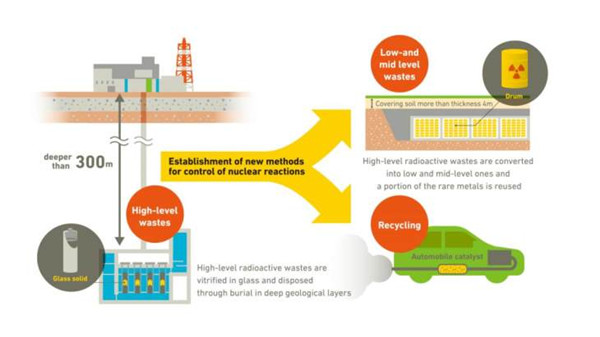Japanese team extracts elements from vitrified waste
Japan's Toshiba Energy Systems & Solutions Corporation has developed oxidation-reduction (redox) treatment technology that enables certain elements to be extracted from vitrified high-level radioactive waste. The technology will allow for the reuse of those elements and a reduction in the volume of high-level waste to be disposed of.

The objectives of the ImPACT research project (Image: JST)
Vitrification is the process for immobilising high-level radioactive waste - such as waste from the reprocessing of used nuclear fuel - in glass. Elements contained within vitrified waste include palladium, selenium, caesium and zirconium, among other long-lived fission products (LLFPs), which have a half-life of about one million years. Toshiba's redox technology uses molten salt to isolate four elements from vitrified waste, to produce potentially reusable metal.
The research was carried out under the Impulsing Paradigm Change through Disruptive Technologies (ImPACT) Programme. It was led by the Cabinet Office's Council for Science, Technology and Innovation. The research aims to investigate the reduction of LLFPs and the recycling of resources from radioactive waste, in addition to converting LLFPs into stable and short-lived nuclides.
The research team - which also includes the Japan Science and Technology Agency - demonstrated that reusable elements can be separated from disposed vitrified wastes by using molten salt technology. A joint statement from the team said the technology, when combined with other technologies being developed under the ImPACT program, such as transmutation, could possibly lead to geological disposal sites being smaller or less deep than before.
In tests, the research team successfully retrieved dummy LLFP nuclides as solids, molten salts and gases by reducing mock vitrified waste in the molten salt where the silicon monoxide network structures of the silicon dioxide were dissolved. The radiation-tolerant molten salt can be used repeatedly resulting in decreased amounts of secondary wastes. The team said it will continue research to provide a practical system to reuse and minimise high-level radioactive waste.
- China Institute of Atomic Energy
- Nuclear Power Institute of China
- Southwestern Institute of Physics
- China Nuclear Power Operation Technology Corporation, Ltd.
- China Nuclear Power Engineering Co., Ltd.
- China Institute for Radiation Protection
- Beijing Research Institute of Uranium Geology (BRIUG)
- China Institute of Nuclear Industry Strategy (CINIS)
- China Nuclear Mining Science and Technology Corporation


